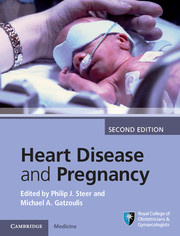21 results
Chapter 61 - Dysfunctional Labor (Content last reviewed: 20th February 2020)
- from Section 6 - Late Prenatal – Obstetric Problems
-
-
- Book:
- High-Risk Pregnancy
- Published online:
- 15 November 2017, pp 1749-1774
-
- Chapter
- Export citation
Chapter 59 - Prolonged Pregnancy
- from Section 6 - Late Prenatal – Obstetric Problems
-
-
- Book:
- High-Risk Pregnancy
- Published online:
- 15 November 2017, pp 1696-1707
-
- Chapter
- Export citation
Chapter 63 - Fetal Compromise in Labor (Content last reviewed: 15th December 2018)
- from Section 6 - Late Prenatal – Obstetric Problems
-
-
- Book:
- High-Risk Pregnancy
- Published online:
- 15 November 2017, pp 1788-1809
-
- Chapter
- Export citation
Chapter 24 - How to Write a Medical Research Paper and Get It Accepted for Publication
-
-
- Book:
- Introduction to Research Methodology for Specialists and Trainees
- Published online:
- 04 August 2017
- Print publication:
- 17 August 2017, pp 188-195
-
- Chapter
- Export citation
Section 4 - Antenatal Care: Specific Maternal Conditions
-
- Book:
- Heart Disease and Pregnancy
- Published online:
- 05 March 2016
- Print publication:
- 17 March 2016, pp 106-207
-
- Chapter
- Export citation
Section 6 - Postpartum Care
-
- Book:
- Heart Disease and Pregnancy
- Published online:
- 05 March 2016
- Print publication:
- 17 March 2016, pp 218-239
-
- Chapter
- Export citation
Appendix B - Antenatal care pathway
-
- Book:
- Heart Disease and Pregnancy
- Published online:
- 05 March 2016
- Print publication:
- 17 March 2016, pp 241-254
-
- Chapter
- Export citation
List of contributors
-
- Book:
- Heart Disease and Pregnancy
- Published online:
- 05 March 2016
- Print publication:
- 17 March 2016, pp vi-viii
-
- Chapter
- Export citation
Section 1 - Pregnancy Counseling and Contraception
-
- Book:
- Heart Disease and Pregnancy
- Published online:
- 05 March 2016
- Print publication:
- 17 March 2016, pp 1-18
-
- Chapter
- Export citation
Copyright page
-
- Book:
- Heart Disease and Pregnancy
- Published online:
- 05 March 2016
- Print publication:
- 17 March 2016, pp iv-iv
-
- Chapter
- Export citation
Contents
-
- Book:
- Heart Disease and Pregnancy
- Published online:
- 05 March 2016
- Print publication:
- 17 March 2016, pp v-v
-
- Chapter
- Export citation
Section 2 - Antenatal Care: General Considerations
-
- Book:
- Heart Disease and Pregnancy
- Published online:
- 05 March 2016
- Print publication:
- 17 March 2016, pp 19-83
-
- Chapter
- Export citation
Section 3 - Antenatal Care: Fetal Considerations
-
- Book:
- Heart Disease and Pregnancy
- Published online:
- 05 March 2016
- Print publication:
- 17 March 2016, pp 84-105
-
- Chapter
- Export citation
Preface
-
- Book:
- Heart Disease and Pregnancy
- Published online:
- 05 March 2016
- Print publication:
- 17 March 2016, pp ix-ix
-
- Chapter
- Export citation
Consensus statements
-
- Book:
- Heart Disease and Pregnancy
- Published online:
- 05 March 2016
- Print publication:
- 17 March 2016, pp x-xiv
-
- Chapter
- Export citation
Plate section
-
- Book:
- Heart Disease and Pregnancy
- Published online:
- 05 March 2016
- Print publication:
- 17 March 2016, pp 266-267
-
- Chapter
- Export citation
Index
-
- Book:
- Heart Disease and Pregnancy
- Published online:
- 05 March 2016
- Print publication:
- 17 March 2016, pp 255-265
-
- Chapter
- Export citation
Section 5 - Intrapartum Care
-
- Book:
- Heart Disease and Pregnancy
- Published online:
- 05 March 2016
- Print publication:
- 17 March 2016, pp 208-217
-
- Chapter
- Export citation
Appendix A - New York Heart Association classification of cardiovascular disease
-
- Book:
- Heart Disease and Pregnancy
- Published online:
- 05 March 2016
- Print publication:
- 17 March 2016, pp 240-240
-
- Chapter
- Export citation

Heart Disease and Pregnancy
-
- Published online:
- 05 March 2016
- Print publication:
- 17 March 2016



